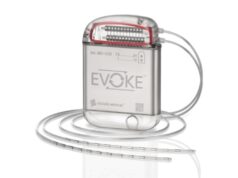
The principle of medical necessity “should drive all remote monitoring decisions” relating to spinal cord stimulation (SCS) technologies, according to recommendations recently published in Neuromodulation: Technology at the Neural Interface by a panel of pain management experts. The panel also asserts that, while the expansion of SCS device capabilities holds the potential to improve outcomes and drive individualised patient care, “more clinical evidence is needed”.
“Emerging SCS remote monitoring and programming technologies provide a unique opportunity to address challenges of in-person visits and improve patient care, although clinical guidance on implementation is needed,” the experts, led by Peter Staats (National Spine and Pain Centers, Atlantic Beach, USA), write. “The goal of this document is to establish best clinical practices for integration of remote device management into the care of patients with SCS, including remote monitoring and remote programming.”
Staats et al note that a panel of experts in the SCS sphere—including interventional pain physicians and neurosurgeons—met in July 2022, with additional experts contributing to the development of the recommendations after this meeting via survey responses and correspondence.
The recommendations state that the overall goal of remote management is “not only to reduce the need for office visits but, more significantly, to identify new SCS-related issues and reduce response time for prompt resolution with the goal of improving patient outcomes and satisfaction”.
In its recent publication, the panel identifies several metrics for remote monitoring and classifies them into three categories: device-related (e.g. stimulation usage); measurable physiologic or disease-related (e.g. patient physical activity or pedometry); and patient-reported (e.g. sleep quality and pain intensity).
It also makes recommendations for the frequency of reviewing remote monitoring metrics, but further states that “providers should tailor follow-up to individual patient needs”, and advises that periodic reviews of remote monitoring metrics occur separately from automatic monitoring system notifications. In addition, the panel keenly emphasises in its report that these recommendations “are offered with the assumptions that appropriate patient selection, surgical technique and postoperative care are observed”—and goes on to stress that the recommendations “are not intended to replace clinical judgment”.
Staats et al highlight reliance on cellular network connectivity or WiFi access; patients, caregivers and healthcare providers being unfamiliar with such technologies; and poor patient or caregiver compliance with regularly recording patient-reported metrics, as being among the key limitations of remote management approaches for current SCS technologies.
“In many settings,” they continue, “remote SCS device management will not replace in-person visits but instead complement them. If an SCS-related problem persists despite optimisation through remote follow-up, an in-person clinic visit should be scheduled. If remote monitoring activities lead to identification of a new pain issue that is unrelated to the SCS device (e.g. pain in a new area, a change in the pain condition), further evaluation including possible in-clinic follow-up should be initiated. Overall, using remote SCS device management will enhance the efficiency and productivity of in-person visits by providing focused rationale and supporting data before the visit.”
The cadence of patient follow-up is “multifactorial”, the panel also writes, adding that device analysis for each patient with an SCS implant is “iterative”, before once again emphasising that decisions surrounding in-person and remote monitoring should be “founded on medical necessity”.
Prior to concluding, the panel notes that its paper constitutes “the first guidance” on the topic at hand, acknowledging that recommendations “will evolve over time” to address new technical innovations, and changes in governmental and payer policy.
“As seen previously with remote management in the field of cardiology, remote monitoring for SCS is progressing, and more data are needed to further define the role of this technology in the future,” Staats et al add. “The consensus panel concluded that the best methods to achieve this goal are to use large registries based on long-term, big data and conduct prospective studies evaluating the effects of remote SCS management on patient care. Although more evidence will be required, the authors’ shared consensus is that remote device management provides an opportunity to improve patient care in both clinical outcomes and healthcare utilisation.”










